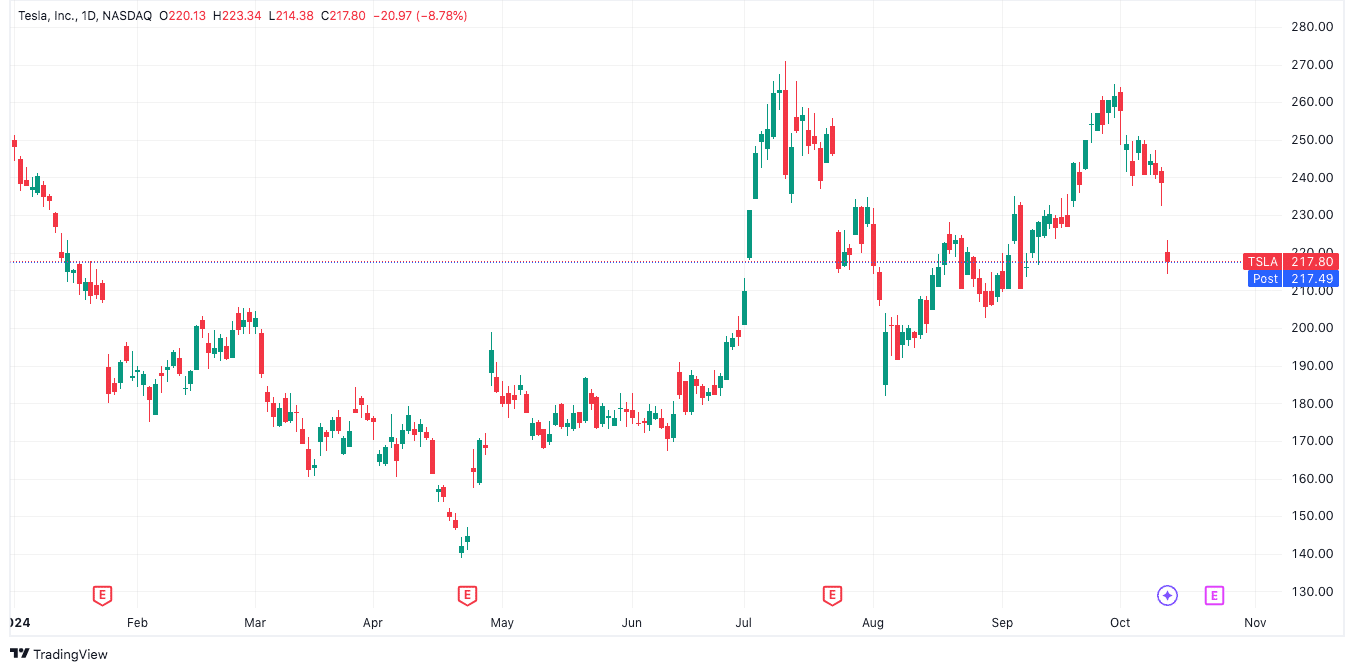It’s been five years since the launch of the Cybertruck but finally, after years of waiting, Elon Musk finally unveiled what is considered Tesla’s most ambitious project – the Cybercab.
During an event called “We, Robot” the head of the electric vehicle manufacturer showed to the public two new models that the company will commercialize for passenger transportation.
First up, the Cybercab – a fully autonomous vehicle with no steering wheels or pedals that features gull-wing doors, a slick aerodynamic design, and inductive (wireless) charging.
Next, the Robovan, another autonomous vehicle capable of transporting up to 20 people that could also be transformed into a cargo van depending on the owner’s needs. The two models are Tesla’s solution to high traffic in urban landscapes.
Cybercab Priced Below $30,000 Production Timelines are Far From Clear
Musk boldly announced the price point of the Cybercab, which will start at $30,000. This makes the vehicle the most affordable autonomous alternative on the market at the moment.
However, the timeline for when these models will start to be assembled was vague as Musk stated that Tesla (TSLA) start producing the Cybercab by 2027 although he admitted that these estimates were quite “optimistic.”
It’s important to remember that Elon Musk’s promises, especially release dates, essentially never come to pass, so don’t hold your breath. For example, in April of 2019, he said that he was confident that Tesla would have fully autonomous Robotaxis by 2020. He also boasts about SpaceX often and said that humans would reach Mars by 2024.
Musk also commented on the financial appeal of the Cybercab and emphasized that it could cost somewhere between 20 cents per mile to operate one of these vehicles or 30-40 cents per mile after taxes.
These lower operational costs would make ride-hailing and personal transportation much more affordable (if he isn’t exaggerating or lying).
The market potential for these autonomous vehicles is substantial. Deutsche Bank estimates that a robotaxi venture could bring Tesla an additional $4 billion in sales and $1 billion in pretax earnings by 2030. Meanwhile, RBC projects that the total global revenue opportunity for robotaxis would be around $1.7 trillion by 2040.
Full Self-Driving (FSD) Continues to Be Tesla’s Holy Grail
Central to both the Cybercab and Robovan is Tesla’s advanced autonomous driving technology. Musk provided updates on the company’s progress in this area, stating that Tesla aims to have “unsupervised FSD” operational in Texas and California by next year for their Model 3 and Model Y electric vehicles. Again, this is likely an exaggeration at best.
The company demonstrated its confidence in the technology by having 21 Cybercabs and a total of 50 autonomous cars on location at the event. Musk emphasized that autonomy is crucial to Tesla’s future.
“If somebody doesn’t believe Tesla’s going to solve autonomy, I think they should not be an investor in the company,” he claimed.
The advancement of Tesla’s Full Self-Driving technology is a critical component of the company’s strategy. Currently, FSD is considered a “level 2” system, meaning that the driver is required to stay alert and be ready to take over the wheel if road conditions demand it.
Also read: Elon Musk’s Political Influence: Backing Trump in 2024
However, Tesla’s goal is to achieve level 4 or 5 autonomy, where the vehicle can operate without human intervention in most or all circumstances. This level of autonomy is essential for the success of the Cybercab and Robovan concepts as it would enable a truly driverless operation in various environments and conditions.
Tesla Needs to Hurry as Competition in the Autonomous Market is Heating Up

While Tesla’s vision for autonomous transportation is ambitious, the company faces significant regulatory challenges. A patchwork of state regulations regarding autonomous vehicles, the need to get signed off by transportation authorities for public road use, and safety concerns all present hurdles that Tesla must overcome.
These regulatory challenges are not unique to Tesla as the entire industry is struggling with how to integrate this new technology into existing transportation frameworks safely and effectively.
Tesla isn’t alone in the race to offer autonomous transportation at scale. Companies like Waymo, which has achieved “level 4” autonomy on its cars, is already operating limited fleets in several US cities. This level of competition drives innovation but also puts pressure on Tesla to deliver on its promises.
The market’s initial response to the Cybercab and Robovan reveal was very negative, with Tesla shares falling by nearly 9% before the closing bell. Since October started, the electric vehicle maker’s stock has fallen by 16.5%. Investors don’t seem to be buying Musk’s exaggerations anymore.
Tesla is Pivoting from Electric Cars to Robotics
The “We, Robot” event showcased more than just vehicles; it highlighted Tesla’s ongoing pivot to robotics and artificial intelligence. Elon Musk also introduced the Optimus humanoid robot, which he claims will be “the biggest product ever of any kind.”
The robots demonstrated their abilities by serving drinks and dancing at the event. Musk clearly envisions a future where personal robots perform tasks like grocery shopping and lawn mowing.
This pivot comes at a time when Tesla’s profitability has slipped and consumer interest in electric cars has cooled in the past couple of years.
The firm’s advancements in the field of robotics could lead to a bright future for transportation and automation. With promises of affordable autonomous vehicles, reduced operational costs, and advanced AI integration, the company is positioning itself at the forefront of a technological revolution.
However, it remains to be seen if Musk, who is known for making unrealistic statements about timelines, features, and prices can deliver what he is promising. Navigating the regulatory challenges, supply chain constraints, and heated competition in the autonomous vehicle space are some of the hurdles he and his company must overcome to lead the charge.